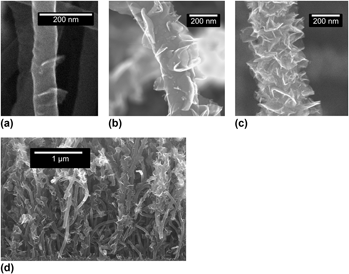Crossref Citations
This article has been cited by the following publications. This list is generated based on data provided by
Crossref.
Stoner, Brian R.
and
Glass, Jeffrey T.
2012.
Carbon nanostructures: A morphological classification for charge density optimization.
Diamond and Related Materials,
Vol. 23,
Issue. ,
p.
130.
Rout, Chandra Sekhar
Kumar, Anurag
Fisher, Timothy S.
Gautam, Ujjal K.
Bando, Yoshio
and
Golberg, Dmitri
2012.
Synthesis of chemically bonded CNT–graphene heterostructure arrays.
RSC Advances,
Vol. 2,
Issue. 22,
p.
8250.
Park, Jungkyu
and
Prakash, Vikas
2013.
Thermal transport in 3D pillared SWCNT–graphene nanostructures.
Journal of Materials Research,
Vol. 28,
Issue. 7,
p.
940.
Feng, Jian-Min
and
Dai, Ye-Jing
2013.
Water-assisted growth of graphene on carbon nanotubes by the chemical vapor deposition method.
Nanoscale,
Vol. 5,
Issue. 10,
p.
4422.
Bo, Zheng
Yang, Yong
Chen, Junhong
Yu, Kehan
Yan, Jianhua
and
Cen, Kefa
2013.
Plasma-enhanced chemical vapor deposition synthesis of vertically oriented graphene nanosheets.
Nanoscale,
Vol. 5,
Issue. 12,
p.
5180.
Atchudan, R.
Joo, Jin.
and
Pandurangan, A.
2013.
An efficient synthesis of graphenated carbon nanotubes over the tailored mesoporous molecular sieves by chemical vapor deposition.
Materials Research Bulletin,
Vol. 48,
Issue. 6,
p.
2205.
Zhang, A Ying
and
Li, Cai Yun
2014.
Advances of Study on the Developments and Physical Properties of Composite Materials.
Applied Mechanics and Materials,
Vol. 633-634,
Issue. ,
p.
379.
Stoner, B.R.
Brown, B.
and
Glass, J.T.
2014.
Selected topics on the synthesis, properties and applications of multiwalled carbon nanotubes.
Diamond and Related Materials,
Vol. 42,
Issue. ,
p.
49.
Fattahi, Pouria
Yang, Guang
Kim, Gloria
and
Abidian, Mohammad Reza
2014.
A Review of Organic and Inorganic Biomaterials for Neural Interfaces.
Advanced Materials,
Vol. 26,
Issue. 12,
p.
1846.
Brown, Billyde
Swain, Benjamin
Hiltwine, Judy
Brooks, D. Bradford
and
Zhou, Zhiguo
2014.
Carbon nanosheet buckypaper: A graphene-carbon nanotube hybrid material for enhanced supercapacitor performance.
Journal of Power Sources,
Vol. 272,
Issue. ,
p.
979.
Oduah, Uzoma I.
2014.
Fabrication of a CHMOSFET with a Combination of P-Carbon Nanotube and an Enhanced NMOS.
International Journal of Materials Science and Engineering,
Henry, Philémon A.
Raut, Akshay S.
Ubnoske, Stephen M.
Parker, Charles B.
and
Glass, Jeffrey T.
2014.
Enhanced electron transfer kinetics through hybrid graphene-carbon nanotube films.
Electrochemistry Communications,
Vol. 48,
Issue. ,
p.
103.
Ubnoske, Stephen M.
Raut, Akshay S.
Brown, Billyde
Parker, Charles B.
Stoner, Brian R.
and
Glass, Jeffrey T.
2014.
Perspectives on the Growth of High Edge Density Carbon Nanostructures: Transitions from Vertically Oriented Graphene Nanosheets to Graphenated Carbon Nanotubes.
The Journal of Physical Chemistry C,
Vol. 118,
Issue. 29,
p.
16126.
Karthik, P.S.
Himaja, A.L.
and
Singh, Surya Prakash
2014.
Carbon-allotropes: synthesis methods, applications and future perspectives.
Carbon letters,
Vol. 15,
Issue. 4,
p.
219.
Zhang, A Ying
2014.
Advances of Study on the Developments and Applications of Carbon Nanotubes.
Applied Mechanics and Materials,
Vol. 597,
Issue. ,
p.
36.
Brown, Billyde
Cordova, Isvar A.
Parker, Charles B.
Stoner, Brian R.
and
Glass, Jeffrey T.
2015.
Optimization of Active Manganese Oxide Electrodeposits Using Graphenated Carbon Nanotube Electrodes for Supercapacitors.
Chemistry of Materials,
Vol. 27,
Issue. 7,
p.
2430.
Ubnoske, Stephen M.
Peng, Qing
Meshot, Eric R.
Parker, Charles B.
and
Glass, Jeffrey T.
2015.
Protocol for High-Sensitivity Surface Area Measurements of Nanostructured Films Enabled by Atomic Layer Deposition of TiO2.
The Journal of Physical Chemistry C,
Vol. 119,
Issue. 46,
p.
26119.
Hussainova, Irina
Ivanov, Roman
Stamatin, Serban N.
Anoshkin, Ilya V.
Skou, Eivind M.
and
Nasibulin, Albert G.
2015.
A few-layered graphene on alumina nanofibers for electrochemical energy conversion.
Carbon,
Vol. 88,
Issue. ,
p.
157.
Wang, Zhipeng
Ogata, Hironori
Morimoto, Shingo
Ortiz-Medina, Josue
Fujishige, Masatsugu
Takeuchi, Kenji
Muramatsu, Hiroyuki
Hayashi, Takuya
Terrones, Mauricio
Hashimoto, Yoshio
and
Endo, Morinobu
2015.
Nanocarbons from rice husk by microwave plasma irradiation: From graphene and carbon nanotubes to graphenated carbon nanotube hybrids.
Carbon,
Vol. 94,
Issue. ,
p.
479.
Chen, Junhong
Bo, Zheng
and
Lu, Ganhua
2015.
Vertically-Oriented Graphene.
p.
55.



